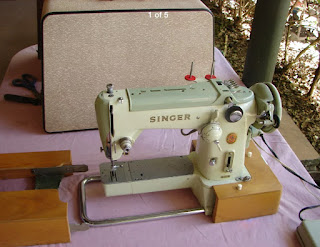Today another vintage Singer sewing machine awaits me in my studio, cleaning products surround it, and empty trash bags lie at the ready.
My husband did not seem pleased to see this machine. I suppose he is right to be worried - I am definitely a collector of expensive and time-consuming hobbies, and now I add vintage sewing machines to that long list. (He likely sees nothing interesting about dismantling a machine and lovingly restoring it, and that is his loss, I say!)
So, the machine is a 1957 201K23. This is my first vintage electric machine, and the electrics will be left for last. I photographed more 'before' images this time around.
THE HEAD
 |
| So brown. |
I've seen the paintwork on this model described as tan/brown or the more whimsical combination of mocha/chocolate. I'd say mine is simply light brown/dark brown.
 |
| Oily black dust. |
Its hard to tell from this photo, but the face plate has a lot of rust below the dark brown enamel, it feels rough. The side not shown in the photo was the worst.
A rusty bobbin winder and very hard rubber tyre, with a flat edge. A new one has been ordered.
 |
| The bobbin winder. |
The bobbin area was grimy, and the bobbin case and retaining clip rusted. I soaked them and treated them with rust converter. This was the first cleaning job I tackled.
 |
| Before: Bring on the D-Solv it. |
I don't know how many years it has been since the bobbin area was cleaned, but the difference was so great that I'll say, decades.
 |
| After: So much better. |
The stitch selector lever was less rusty than the one on my 201K treadle, so I swapped these parts.
 |
| Grime. |
The light has a lot of surface rust, and the Singer logo is almost gone. The light assembly was loose, and you can see how it has scratched an arc in the paintwork next to the "R" on the head as it flopped up and down.
 |
| Scratched paint. |
THE MOTOR
The original motor was nice to see, in it's sturdy little brown bakelite housing. The rear access plate is rusty and grimy, there was rust and splotches of white paint here and there. The motor worries me, I don't know anything about this area. I know I'll be taking it off, and I'm just pleased that in Australia a potted motor is rare and these little easily-removed belt-driven external motors are the norm on vintage Singer machines.
 |
| Singer BAK 4-12 Sewing Motor, 0.3Amps. |
Now for the table, this is a real problem. It can't come into the house with any kind of smell. I scrubbed it with sugar soap, then disinfectant, then I hosed it! The smell did not change. I'm worried.
 |
| Rear view. The table was originally painted light brown, then someone painted just the front and top white. |
The screws that hold the hinges to drop the machine down are much smaller than they should be, and the wood has cracked because the hinge plate moves.
More Singer hardware has been lost and replaced over time, half the screws are missing from the lid.
More next time. :)













Comments
Post a Comment